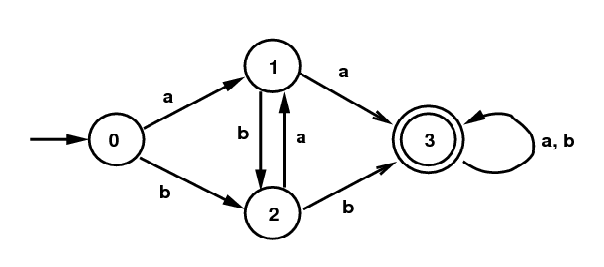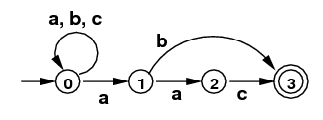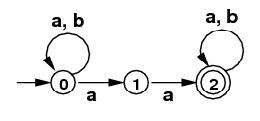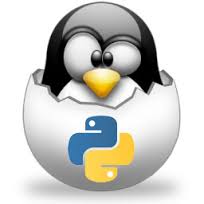|
CS 3721 Programming Languages Spring 2014 | |
Recitation 8.
DFAs & NFAs
| ||
Possible Answers in Red
| ||
Finite Automata:
- Consider the finite automaton below.
(State 9 is an "accepting" state and States 4 and 5
are "error" or "rejecting" states.)

FSM for doubles, where "d" stands for any digit (the "suffix" is not included)- Is this an NFA or a DFA? (Always give reasons! Because there aren't any two arrows from the same state with the same label.)
- Suppose the FA processes the string "13.2$"
(where '$' is just a terminator that we will often use.)
It will start in State 0 and proceed along from state to state
as it processes character after character:
1 3 . 2 $ 0 ---> 1 ---> 1 ---> 3 ---> 3 ---> 9 - Do the same for the string "13E+$"?
Explain why the result means that it has not accepted the second string.
1 3 E + $ 0 ---> 1 ---> 1 ---> 6 ---> 3 ---> 5 - Write several strings that are recognized by this FA,
and give the sequence of states as above. Include enough examples
of strings that are accepted
so that every arrow of the diagram is used while accepting
one of the example strings.
(This does not include arrows pointing to "error" states.)
The string below, along with the one in part
b, reaches all the non-error states, but it's still missing
a few arrows to non-error states.
. 3 E + 4 $ 0 ---> 2 ---> 3 ---> 6 ---> 7 ---> 8 ---> 9
Simulating a DFA:
- Write a program in C or in Java, perhaps similar to the one at
abb
(but it doesn't have to be similar),
that will simulate (or model) the actions of the following DFA:

DFA for /(a|b)*(aa|bb)(a|b)*/
| Java Program | Output |
|---|---|
// Prob2.java: recognize (a|b)*abb
import java.io.*;
public class Prob2 {
private GetChar getChar;
private char ch;
private int state = 0;
public Prob2() {
getChar = new GetChar();
state = 0;
}
public void process() {
while (true) {
ch = getChar.getNextChar();
if (ch == '$') break; // out of while
switch (state) {
case 0: if (ch == 'a') state = 1;
else if (ch == 'b') state = 2;
break;
case 1: if (ch == 'a') state = 3;
else if (ch == 'b') state = 2;
break;
case 2: if (ch == 'a') state = 1;
else if (ch == 'b') state = 3;
break;
case 3: if (ch == 'a') state = 3;
else if (ch == 'b') state = 3;
break;
}
System.out.print("ch: " + ch + ", next state: "
+ state);
if (state == 3) System.out.print(" Terminal");
System.out.print("\n");
}
if (state == 3) System.out.print("Accept\n");
else System.out.print("Reject\n");
}
public static void main(String[] args) {
Prob2 prob2 = new Prob2();
prob2.process();
}
}
| % java Prob2 babaabab$ ch: b, next state: 2 ch: a, next state: 1 ch: b, next state: 2 ch: a, next state: 1 ch: a, next state: 3 Terminal ch: b, next state: 3 Terminal ch: a, next state: 3 Terminal ch: b, next state: 3 Terminal Accept |
Subset Algorithm:
- Use the subset algorithm to convert the following NFA
into a DFA that accepts the same language.
(Hint: The DFA also has 4 states.)

NFA for /(a|b|c)*(ab|aac)/
(Intuitively, any string of "a"s, "b"s, and "c"s,
ending in "ab" or "aac".)State a b c S 0 {0} 1 {0,1} 0 {0} 0 {0} 1 {0,1} 2 {0,1,2} 3 {0,3} 0 {0} 2 {0,1,2} 2 {0,1,2} 3 {0,3} 3 {0,3} T 3 {0,3} 1 {0,1} 0 {0} 0 {0} State a b c S{0} {0,1} {0} {0} {0,1} {0,1,2} {0,3} {0} {0,1,2} {0,1,2} {0,3} {0,3} T{0,3} {0,1} {0} {0} - Use the subset algorithm to convert the following NFA
into a DFA that accepts the same language.

NFA for /(a|b)*(aa)(a|b)*/
(Intuitively, any string of "a"s, and "b"s,
containing "aa" somewhere.)State a b S 0 {0} 1 {0,1} 0 {0} 1 {0,1} 2 {0,1,2} 0 {0} T 2 {0,1,2} 2 {0,1,2} 3 {0,2} T 3 {0,2} 2 {0,1,2} 3 {0,2}
You must show your work. You don't need to draw a diagram of the DFA resulting from using the subset algorithm. (You should draw a diagram for your private use in seeing if you seem to have the right answer.) Your answers can look like the items in the link above identified as "Tables" and labeled "DFA". Don't write a table for the input NFA.
Revision date: 2014-03-24. (Please use ISO 8601, the International Standard.)
